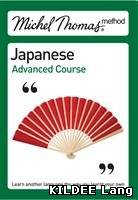Главная »
2009 » Март » 20 » Michel Thomas Method: Japanese Advanced Course: Niamh Kelly and Helen Gilhooly
13:29 Michel Thomas Method: Japanese Advanced Course: Niamh Kelly and Helen Gilhooly |
|
Michel Thomas Method: Japanese Advanced Course
Author: Niamh Kelly and Helen Gilhooly
Publication date: 27/02/2009
ISBN: 9780340974599
Format / Quality: mp.3/ 128Mbps (rar +3% recovery) (No booklet)
Size: 291 Mb
The NEW Japanese Advanced Course
A five-hour, 100% audio method, written by teachers Niamh Kelly and Helen Gilhooly, for taking your Japanese to an advanced level. Join Nia
Learn another language the way you learnt your own
Effective method - the Michel Thomas Method of language teaching works with the brain
Motivating - live classroom situation with two students encourages you to learn with the students on the recording
All-audio - the way you want to learn
Pronunciation is gently - but effectively - corrected
Reference booklet - accompanying booklet lists key phrases in English and Japanese (romaji Roman script)
Suite of progressive and complementary course components: Introductory, Foundation, Advanced, and Vocabulary
Sales record - the hugely successful Michel Thomas Method is applied to Japanese
Table of Contents:
‘it is’ - ‘desu’; ‘it is X’ / ‘it was X’ - ‘it’ understood, not stated; no marker immediately before ‘desu’
‘this / that is X’ / ‘this / that was X’ - marker after ‘this / that’
‘it is not’ = ‘ja arimasen’; ‘it is not / was not X’; ‘this / that is not / was not X’
use of markers with ‘desu’ and variants
‘like’ = ‘suki desu’ = ‘is likeable’; ‘hate / good at / bad at’ all form negative with ‘ja arimasen’
‘strong point’ - ‘tokui desu’
‘kirei’ - ‘clean / beautiful’; ‘kantan’ - ‘easy’; ‘shinsetsu’ - ‘kind’; ‘benri’ - ‘convenient’
markers ‘wa’ and ‘ga’
giving reasons in past with ‘kara’
‘kakimasu’ - ‘write’
‘want / don’t want’ verb ending
‘hana’ - ‘flower’
‘while’ verb suffix ‘-nagara’ in present / past /affirmative / negative
‘while’ verb suffix ‘-nagara’ used only when both verbs have same subject. ‘sono aida’ for ‘while’ with different subjects
‘imasu / arimasu’ - ‘exist’ also used for ‘have’ construction (‘as for me, X exists’ = ‘I have X’)
to link verbs within a sentence, change the ‘-masu’ ending to ‘-te’. The last verb in the sentence will be in the ‘-masu’ form.
verbs that have irregular ‘-te’ forms
‘-te’ verb form shows sequence
‘-te’ verb form in past tense - only main (final) verb will be in ‘-mashita’ form
‘kudasai’ + verb in ‘-te’ form to make request
‘kara’ after ‘-te’ verb form to mean ‘following / after’ (not related to ‘kara’ for reason)
‘-mono’ suffix can replace ‘-masu’ ending of some verbs to produce a noun
‘imasu’ - ‘exist’ + ‘-te’ verb form has sense of ‘right now in the process of X-ing’
‘hairimasu’ - ‘enter’; ‘demasu’ - ‘leave’ + markers
past tense of ‘imasu’ - ‘exist’ + ‘-te’ verb form has sense of ‘was X-ing’
‘is / was X-ing’ in negative
‘ima’ - ‘now’
‘nanimo’ - ‘nothing’ used with negative verb
‘mimasu’ - ‘see’ + ‘-te’ verb form has sense ‘try and X’ (+ in past tense; with suggestions, etc.)
suffix ‘-mo’ added to ‘-te’ verb form has sense ‘even if / though’
‘-te’ verb form + ‘mitemo’ = ‘even if I try to’
‘nani’ - ‘what’ + ‘-temo’ verb form = ‘no matter what I X’; with ‘doko’ - ‘where’ = ‘wherever I X’; with ‘dare’ - ‘who’ = ‘whoever I X’
‘ii desu’ - ‘it is fine / OK’ added after ‘-temo’ verb form = ‘even if you do X it is OK’ = ‘you may do X’
‘-temo ii desu’ + ‘ka’ question marker = ‘may I X?’
‘iie, ikemasen’ to refuse permission
replace ‘-te’ verb suffix by ‘-ta’ as base for more verb structures (‘-ta’ form is also casual form, whereas ‘-masu’ is neutral polite)
‘toki’ - ‘time’
‘-ta’ verb form + ‘toki’ = ‘when I X’ (past tense)
‘koto’ - ‘fact’
adding ‘koto ga arimasu’ after ‘-ta’ verb form = ‘a fact exists’ = ‘the fact of having done exists’ = ‘I have X’ (past tense form)
comparison of ‘-ta toki’ and ‘-ta koto ga arimasu’ past tenses (e.g. ‘I went’ vs. ‘I have been’; ‘I saw’ vs. ‘I have seen’)
‘hanami’ - ‘flower viewing’
‘ho ga ii desu’ - ‘it is better’
‘-ta’ verb form + ‘ho ga ii desu’ = ‘it is better if you X’ = ‘you should X’
‘
‘-ta’ verb form + ‘-ra’ suffix = hypothetical situation ‘if I / you / he X’
listing a number of verbs in ‘-ta’ form + ‘-ri’ suffix, then ‘shimasu’ - ‘do’ / ‘shimashita’ - ‘did’ has sense ‘I do / did such things as X, Y, Z’ - no particular order is implied, unlike with the ‘-te -masu’ or -te kara’ forms
About the Author(s):
Helen Gilhooly is Director of the Language Faculty at Aldercar Community Language College, Derbyshire, UK and has taught Japanese at Nottingham University. She is author of various 'Teach Yourself' Japanese courses.
Niamh Kelly is Lecturer in the Japanese Department at Dublin City University, Ireland.
|
|
Категория: Японский|Japanese |
Просмотров: 1894 |
Добавил: tatarinx
| Рейтинг: 0.0/0 |
Добавлять комментарии могут только зарегистрированные пользователи.
[
Регистрация |
Вход ]
